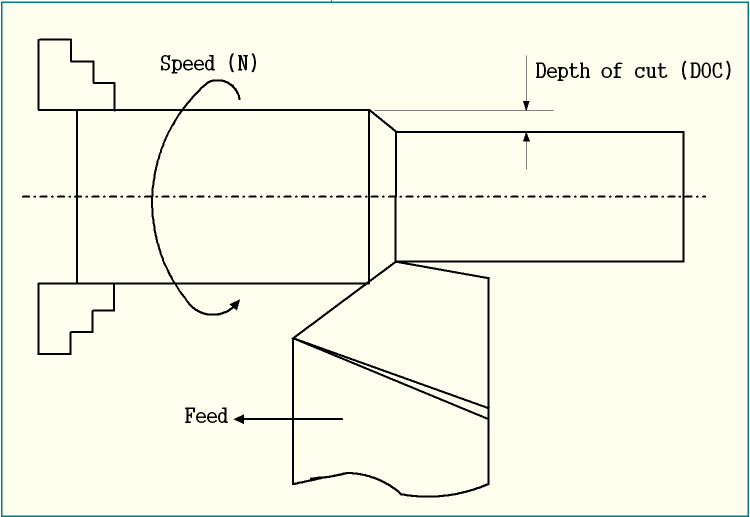Machining is basically one material removal process where excess material is gradually removed from the workpiece in the form of chip by feeding the cutting tool against the workpiece. In order to smoothly remove material, three relative motions between tool and workpiece are to be provided. Such motions are cutting velocity (or cutting speed), feed rate and depth of cut. Since these three parameters are inherent to any conventional machining process, so they are also called cutting parameters.
What is feed rate?
Feed rate is one of the cutting parameters, which is provided for moving the tool against the workpiece for covering the entire surface to be machined. Usually it is imparted in a direction perpendicular to cutting velocity; however, the angle between cutting velocity vector and feed vector may also deviate from 90º. The following schematic diagram for straight turning operation shows the feed direction in conjunction with speed and depth of cut.

Units of feed rate
Various machining operation use different unit in order to express feed rate in the most suitable way particularly for that process. The below list displays the common unit of feed rate used in various machining operations. Irrespective of the unit, the purpose of the feed rate remains unaltered as discussed earlier.
- Turning—mm/rev, applied on cutting tool.
- Milling—mm/tooth, applied on cutting tool.
- Drilling—mm/rev, applied on cutting tool.
- Shaping—mm/stroke, applied on work table (workpiece).
- Planing—mm/stroke, applied on cutting tool.
- Slotting—mm/rev, applied on work table (workpiece).
- Grooving—mm/rev, applied on cutting tool.
- Knurling—mm/rev, applied on cutting tool.
Effects of feed rate in machining
Since feed rate is one of the three cutting parameters so its value has to be selected carefully prior to the actual machining operation. Improper feed rate can lead to inaccuracy in machining and thus production of rejected parts. Feed rate affects machining performance in many ways—surface finish to tool life, as discussed below. For detail, you may also read effects of feed rate on machining performance.
- Higher feed rate indicates higher material removal rate (MRR) as MRR is directly proportional to the feed rate. So productivity can be enhanced by using higher feed rate.
- However, higher feed rate results in poor surface finish. The scallop marks and thus the surface roughness value will be higher. In order to obtain smooth surface, lower feed rate should be used.
- High feed rate also accelerates tool wear and thus tool life degrades.
Typical value for feed rate in machining
Value of feed rate affects machining performance and economy, so an optimum value is always desirable. Typical values for feed rate in several conventional machining operations are provided below.
- Feed rate in straight turning—0.01 – 0.1mm/rev for finishing cut; 0.05 – 0.5mm/rev for rough cut.
- Feed rate in thread turning—Equals to the pitch or lead (for multi-start threads) of thread (usually 0.5 or 1.0mm/rev).
- Feed rate in drilling—Must be very low otherwise tool may break due to chip clogging. Typical value is 0.01 – 0.05mm/rev.
- Feed rate in milling—Usually 0.05 – 0.10mm/rev.
- Feed rate in knurling—0.5 – 1.0mm/rev (Cutting speed is usually very small in knurling but feed rate is very high).
Pros and cons of improper feed rate
Prior to machining, selection of optimum feed rate is crucial as a number of factors are affected by the process parameter. An optimization can help finding out suitable range for feed rate for machining a particular material under specific conditions and cutting environment. However, considering all possible factors is sometime difficult and thus, in machine shop, its value is commonly selected from practical experience. The following table displays the impacts on machining performance if feed rate is improper.
| Effects of too high feed rate | Effects of too low feed rate |
|---|---|
| High surface roughness (inferior surface finish) | Under-utilization of machine tool |
| Excessive tool wear and high chances of catastrophic failure of tool. Thus reduced tool life | Poor material removal rate (MRR) |
| Higher idle time for frequent tool changing and thus high production cost | Reduced productivity and thus higher machining time and production cost |
| More chip deviation from orthogonal plane | Wider burr |
| Discontinuous chip formation | |
| High cutting temperature and chip burning | |
| High tendency of built-up edge (BUE) formation | |
| High cutting force and risk of vibration |
Selection of feed rate
There exist a large number of factors which should be considered for selecting an optimum value of feed rate, as discussed below. Note that the following list is just few of such factors that need consideration while choosing feed rate value.
Surface finish requirement—Lower feed rate gives good surface finish. So if operation is rough cut then a higher value can be considered. For example, for rough turning a feed rate of 0.1 – 0.3mm/rev can be taken; whereas, for finishing pass, 0.01 – 0.05mm/rev can be considered.
Productivity requirement—In case of higher productivity requirement, feed rate can be increased, if surface quality can be sacrificed. Otherwise, cutting speed (rpm) can be increased maintaining feed rate unchanged.
Permissible feed rate—Machine tools have a maximum and minimum limit of feed rate, beyond which, selection is not permitted. Again, conventional machine tools may have only few feed rate options within that range.
Cutting tool geometry—Beside feed rate, tool geometry also affects surface quality. So, if geometry permits, then a higher value can be selected.
Machine capability—Higher feed rate causes high cutting force and vibration. Depending on the capability of machine tool to absorb and transmit such forces and vibrations, feed rate should be chosen.
References
- Book: Machining and Machine Tools by A. B. Chattopadhyay (Wiley).
- Book: Metal Cutting: Theory And Practice by A. Bhattacharya (New Central Book Agency).